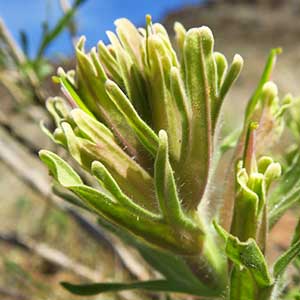Castilleja occidentalis
Castilleja xanthotricha
western Indian paintbrush, western or western yellow paintbrush, western paintbrush
John Day or yellow-hairy paintbrush, John Day paintbrush, yellow hair paintbrush, yellow-hair Indian paintbrush
several to many, erect or ascending, usually short-decumbent at base, unbranched, sometimes glabrous proximally, hairs spreading, long, soft, mixed with medium length to short stipitate-glandular ones only in inflorescence.
few to several, ± decumbent to erect or ascending, unbranched, sometimes with short, leafy axillary shoots, hairs erect to spreading, long, soft, eglandular, mixed with short stipitate-glandular ones.
green to deep purple, linear-lanceolate to broadly lanceolate (to linear on sterile shoots), 1.5–4(–5.5) cm, not fleshy, margins plane, flat, prominently veined, 0–3(–5)-lobed, apex acute to rounded;
lobes ascending, lanceolate, apex acute.
green, linear, lanceolate to broadly lanceolate, oblong, or cuneate, 0.8–5 cm, not fleshy, margins plane to wavy, involute, 0–5-lobed, apex acute, sometimes rounded;
lobes spreading, linear, arising below mid length, nearly as broad as center lobe, apex acute.
2–7(–10) × 1–3.5 cm;
bracts greenish to pale greenish yellow throughout, often aging dull reddish brown or reddish purple proximally, rarely dull reddish brown throughout, or proximally green, dull reddish brown, or reddish purple, distally greenish white, yellow, or cream, broadly lanceolate to widely oblong to ovate, 0–3(–7)-lobed;
lobes ascending, triangular to lanceolate, medium length, usually arising at or above mid length, rarely just below, central lobe apex obtuse to rounded, others acute.
3–14 × 1.5–4.5 cm;
bracts proximally greenish, rarely dull reddish purple, distally white to cream, rarely pale yellow or dull, pale pink (sharply differentiated from proximal coloration), lanceolate or oblong to narrowly ovate, (3–)5–7-lobed;
lobes ascending, linear to obovate, ± broadened distally, medium, long, proximal lobes arising below mid length, central lobe apex broadly rounded to truncate, others acute to rounded.
straight, 16–25 mm;
tube 9–15 mm;
teeth and part of abaxial lip sometimes exserted, beak exserted;
beak adaxially green, (2.5–)5–9 mm;
abaxial lip green, reduced, often visible through abaxial cleft, slightly pouched, 1.5–3 mm, 25–50% as long as beak;
teeth incurved to ascending, white, sometimes green, 0.7–2 mm.
curved, 17–23 mm;
tube 15–19 mm;
beak exserted, adaxially green, 5–8(–9) mm, puberulent, stipitate-glandular;
abaxial lip deep purple (color sometimes visible through calyx), green, pinkish, or pale yellow, ± prominent, slightly inflated, usually hidden in calyx, sometimes right at top of calyx, 2 mm, ca. 50% as long as beak;
teeth ascending, whitish, yellowish, pink, or green, 1–1.5 mm.
proximally green to purple, distally colored as bracts, 12–20 mm;
abaxial and adaxial clefts 5–9(–10) mm, 40–50% of calyx length, deeper than laterals, lateral 1–3(–4.5) mm, 5–20% of calyx length;
lobes lanceolate to triangular, apex acute, obtuse, or rounded.
colored as bracts, 15–26 mm;
abaxial and adaxial clefts 3.5–7 mm, 25–50% of calyx length, deeper than laterals, lateral 2–5 mm, 12–25% of calyx length;
lobes linear, oblong, or narrowly triangular, center lobe apex usually rounded, lobes acute to rounded.
= 24, 48.
= 48.
Castilleja occidentalis
Castilleja xanthotricha
Castilleja occidentalis has a wide distribution in the southern Rocky Mountains, a gap in its distribution in Wyoming, and reappears in Montana and the Canadian Rockies. Bract lobing and color vary considerably but without correlation to geography. Although C. occidentalis resembles an alpine form of C. septentrionalis, C. occidentalis is missing in several regions in the distribution of the latter, even when extensive areas of suitable habitat are available, and has a discrete range.
(Discussion copyrighted by Flora of North America; reprinted with permission.)
Castilleja xanthotricha is endemic to moderate elevations in the sagebrush hills of the John Day River drainage in north-central Oregon. N. H. Holmgren (1971) hypothesized that this tetraploid species is of allopolyploid hybrid origin between C. glandulifera and C. oresbia.
(Discussion copyrighted by Flora of North America; reprinted with permission.)


